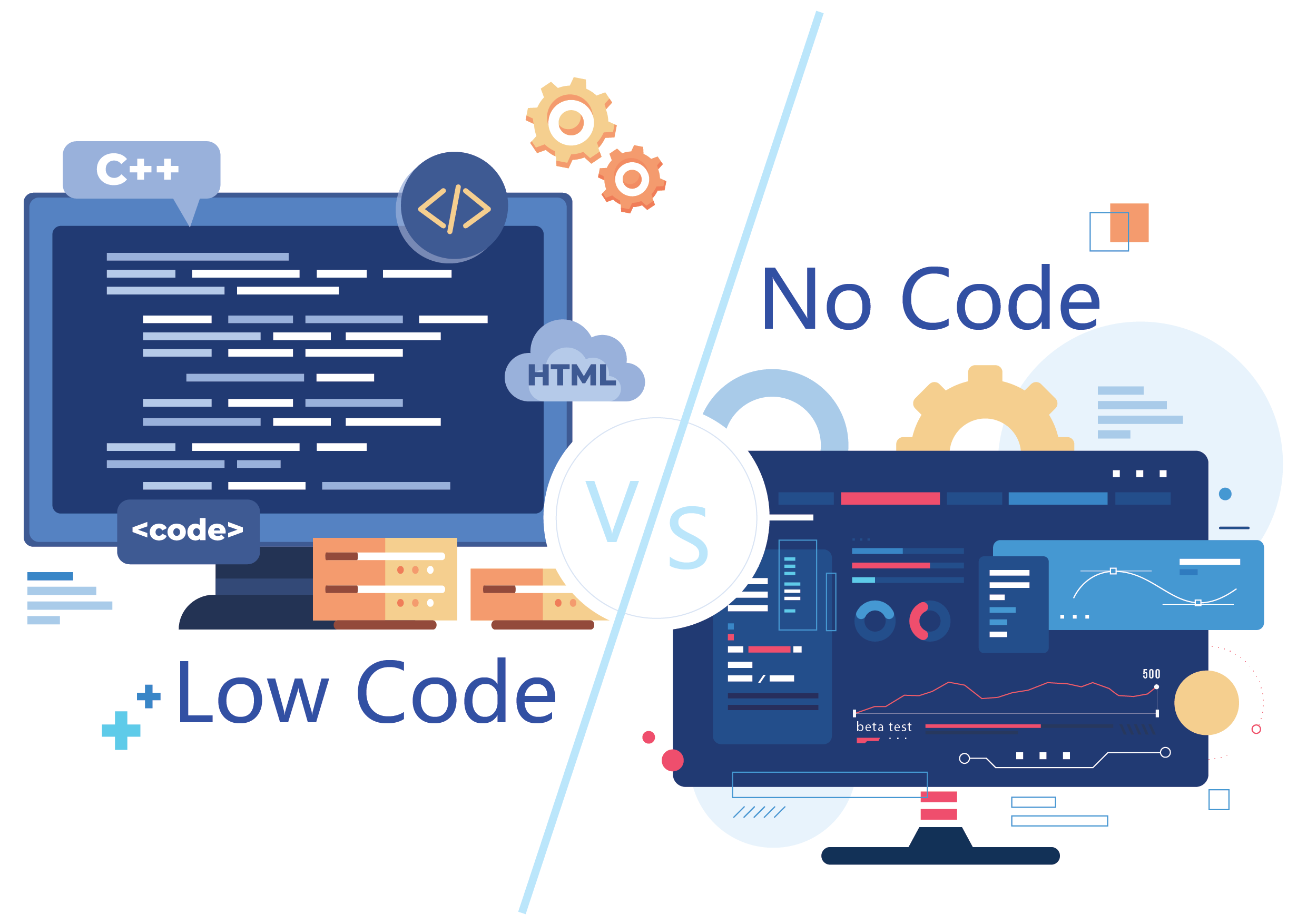Gartner predicts that by 2024, 65% of the applications will be developed using low-code methods. In concluding, low-code AI is an instrumental catalyst in transforming the landscape of software development.
Continue readingLow code vs No code: A comprehensive comparison
The rise of low code and no code platforms has played an essential role in the 21st century. These innovative technologies are not only making app development accessible to citizen developers, but are also breaking down barriers and democratising innovation across industries.
The most common question raised in terms of low code & no code platforms is what is the difference between the two? Although they aim for the same goal, to bring speed to the business by decreasing software development time in a go-to-market approach. Still, there are a number of significant differences between “low code” and “no code” platforms.
Let’s take a closer look at each approach and understand better.
What is No code?
No code refers to a development tool that empowers non-technical users to build applications. Instead of writing code, no code platforms offer visual-based interfaces and pre-built templates, allowing users to simply drag and drop components into logical sequences to build fully functional business applications. In the background, the platform automatically generates the necessary code, making the app functional.
However, no code does have its own downside: while it enables users to build applications rapidly, they are limited to the provided templates. This limitation results in reduced flexibility and scalability when attempting to incorporate highly customized features or integrate with existing systems.
What is Low code?
As the name suggests, low code platform enables developers to write custom code when necessary to meet specific and complex business requirements. Unlike No-Code platforms, Low-Code platforms include automation capabilities, component reusability, and integration capabilities, making them capable of handling scalability and ensuring cross-platform compatibility.
In summary, low code offers a middle ground between traditional coding and no code solutions, making them suitable for a wide range of users, from citizen developers to software developers.
Low code vs No code: The differences
Now that you have a grasp of both low code and no code platforms, how do you determine the ideal choice for your needs? While these two simple workflow applications share many common traits, there are a few fundamental differences that are crucial to consider.
The following table presents the main differences between low code and no code –
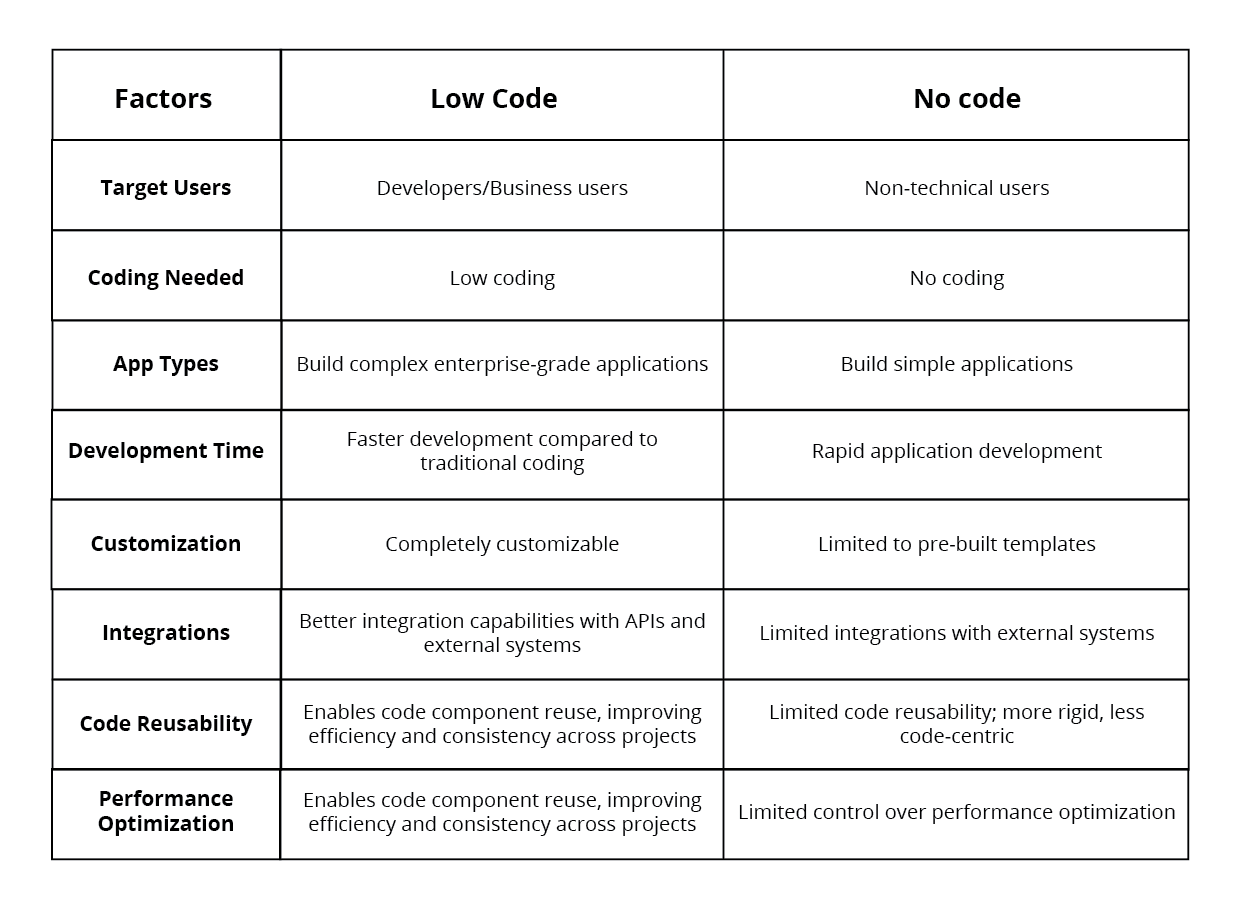
No code vs Low code: When to use what
When selecting between low code and no code development for your project, it’s essential to consider your application’s specific requirements and characteristics. Here are some factors to keep in mind:
The Complexity of the Project
Low-code platforms are well-suited for applications that involve moderate complexity and customization. They balance visual development and the ability to incorporate custom code when needed. On the other hand, if your project is relatively simple and doesn’t require extensive customization, a no-code platform might be more suitable.
Development Skills and Resources
If you have developers with coding expertise and the ability to write code, a low-code platform can provide the flexibility to incorporate their skills while benefiting from the visual development environment. On the other hand, if your team consists mainly of non-technical individuals or you have limited development resources, a no-code platform allows you to create applications independently without relying on coding skills.
Time Constraints
Low-code development is faster than traditional coding, making it a quick way to get your app to market. But if time is tight and you need to build a lightning-fast simple app, no-code is faster because it doesn’t involve any coding.
Scalability and Future Needs
Low-Code platforms provide greater flexibility and extensibility, allowing you to incorporate custom code and integrate with external systems. No-code platforms, while more limited in customization options, are ideal for projects with specific requirements that foresee little future expansion.
A few industry use cases
Low-Code has versatile applications across multiple industries. Here are some prevalent use cases:
Manufacturing Sector
Procurement Management
- Vendor Profile Management: Streamline vendor profile management by creating custom applications and simplifying the process of storing and updating vendor qualifications and pricing data.
- Purchase Request Management: Users can easily build purchase request systems to streamline and automate the request submission and approval process.
- Purchase Order Tracking: Track and approve purchase orders in real-time with custom-built applications, reducing manual intervention.
- Procurement Analytics: Utilize reporting capabilities to generate detailed reports on procurement costs and trends, aiding in cost optimization.
Supply Chain Management
- Material Tracking: Track the movement of materials and products through the supply chain, providing visibility and control over the entire process.
- Supplier Relationship Management: Build applications to manage supplier relationships, enhancing collaboration and communication.
- Supply Chain Analytics: Generate reports on supply chain efficiency and costs to identify areas for improvement and cost reduction.
Healthcare Sector
Patient Management
- Outpatient and Inpatient Management: Efficiently handle patient admissions, discharges, and transfers, ensuring seamless patient flow within the healthcare facility.
- Patient Onboarding and Registration: Develop user-friendly onboarding and registration processes for patients, reducing paperwork and enhancing the patient experience.
- Patient Portal: Create a comprehensive patient portal for appointment scheduling, accessing test results, reviewing medication history, and improving patient engagement and self-service.
Maintenance Management
- Maintenance Tracking: Efficiently track assets and equipment in healthcare facilities, ensuring timely maintenance and minimizing downtime.
- Maintenance Task Scheduling: Develop applications to schedule preventive maintenance tasks, ensuring the proper upkeep of critical equipment.
- Maintenance Reports: Utilize reporting capabilities to generate detailed reports on maintenance costs and equipment repairs, aiding in cost control and asset management.
Financial Sector
Customer Onboarding
- Customer Profile Management: Applications facilitate the creation and management of customer profiles, including critical information such as contact details, financial data, and risk appetite.
- Onboarding Process: The technology streamlines the customer onboarding process, including essential Know Your Customer (KYC) and Anti-Money Laundering (AML) checks, reducing manual work and ensuring regulatory compliance.
- Reporting: Comprehensive reports on customer onboarding activities are generated, offering valuable insights for decision-making and compliance audits.
KYC (Know Your Customer)
- Identity Verification: Applications simplify Know Your Customer (KYC) checks to verify customer identities and financial statuses, a crucial aspect of compliance.
- Automated KYC: The KYC process can be automated, ensuring adherence to regulations, including Aadhaar and PAN compliance.
- Activity Reports: Robust reporting capabilities provide clear overviews of KYC activities, aiding in compliance efforts and identifying areas for improvement.
Loan Origination
- Streamlined Loan Applications: Technology assists in creating and managing loan applications, simplifying the process for both customers and financial institutions.
- Loan Origination Solutions: The loan origination process, including underwriting and verification, can be automated, enhancing efficiency and reducing processing time.
To Conclude
Both low-code and no-code solutions come with their own advantages. Choosing between the two can be tricky due to their similarities. The best approach is to look at your current needs and decide accordingly.
Get in touch with Amoga experts to embark on your low-code journey today! Amoga is a low-code work platform that empowers businesses to build enterprise-grade applications 10 times faster and at 25% lower cost than traditional software. Organizations can break free from complex software limitations with features such as Pre-built App templates, App Studio, Visual UI builders, Form Builders, and Customized Workflow. Book your demo today and start building apps with Amoga.
An Overview of Low code No code market in 2023
The low code no code development market is rapidly growing, and it is expected to continue to grow in the years to come. This is due to a number of factors, including the increasing demand for digital transformation, the need for rapid application development, and the desire for greater business agility. The worldwide market for low-code development technologies is projected to total $26.9 billion in 2023, an increase of 19.6% from 2022, according to the latest forecast from Gartner. A rise in business technologists and a growing number of enterprise-wide hyper-automation and composable business initiatives will be the key drivers accelerating the adoption of low-code no-code technologies through 2026.
Why the sudden low code no code market growth?
Low-Code No-Code development is a software development methodology that uses graphical user interfaces (GUIs) and other visual tools to create applications and enable business users and professional developers to create applications. This approach to development reduces the amount of coding required, making it easier and faster for businesses to build the applications they need.
So, it’s not a surprise that in a time when customer expectations are constantly changing, companies are looking for tools that can support hybrid work, and competition is becoming fiercer than ever, low-code No-Code development is on the rise.
Why is low-code development growing in popularity?
There are several reasons why Low-Code No-Code development is growing in popularity. These include:
-
- The increasing demand for digital transformation: Businesses are increasingly looking to digitalise their operations in order to stay competitive. Low-code development can help businesses quickly and easily build the applications they need to support their digital transformation initiatives.
-
- The need for hyper-automation: The orchestration of multiple advanced technologies that promote end-to-end business process automation is called hyper-automation. Businesses need to be able to develop applications quickly in order to keep up with the pace of change. Together with robotic process automation tools, artificial intelligence, and machine learning, low-code has emerged as a key tech solution for supporting successful hyper-automation initiatives.
-
- The desire for greater business agility: Businesses need to be able to adapt quickly to changes in the market. Low-code No-Code development can help businesses do this by making it easier to build and deploy new applications.
-
- IT democratisation: On average, 41% of employees in an organisation are “business technologists,” that is, collaborators outside IT departments who create technology or analytics capabilities for their own use. Because most of them don’t come from a traditional development background, they primarily rely on low-code and no-code tools to create the solutions they need.
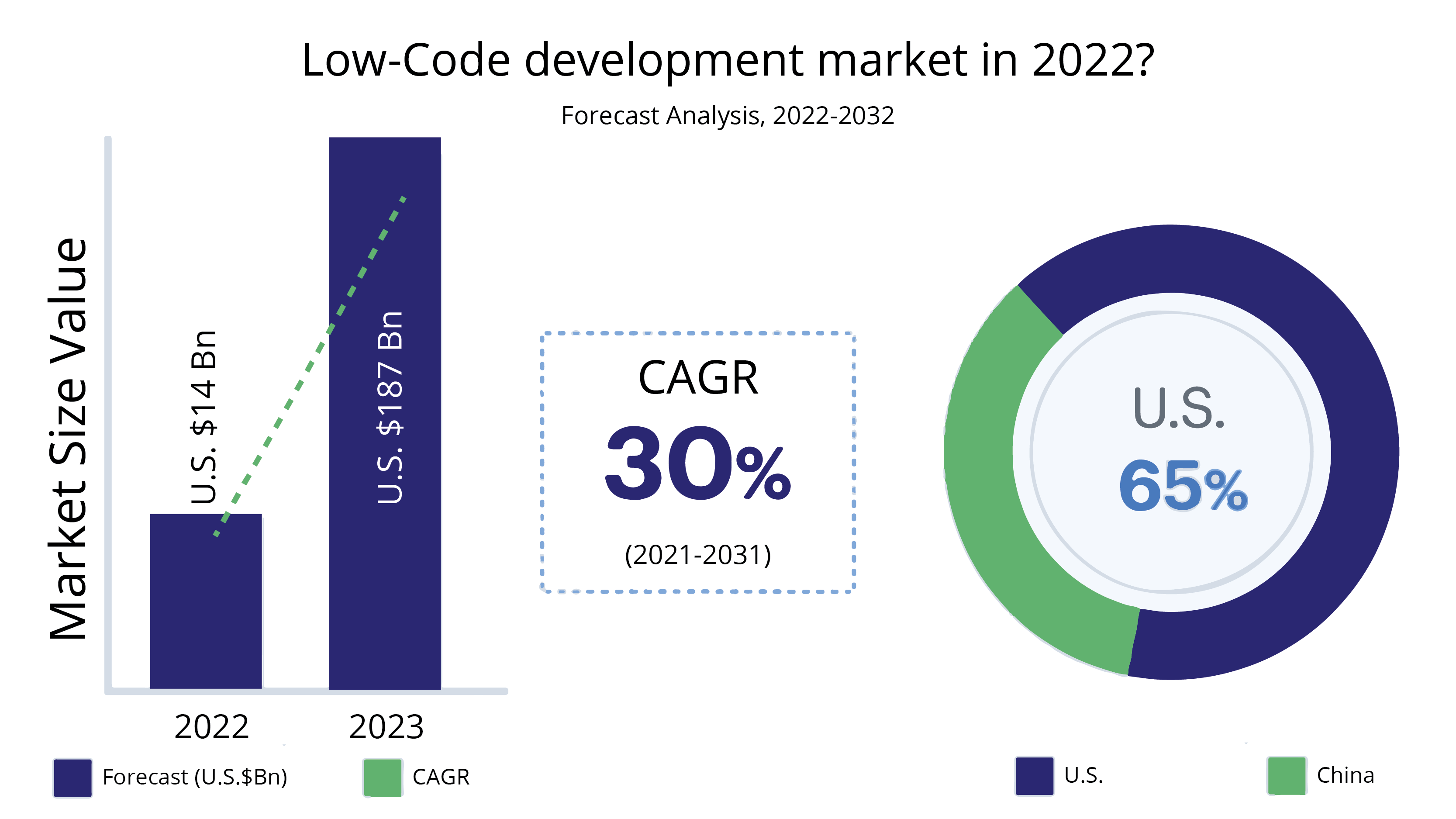
How big is the low-code market?
The low-code global market is expected to be around $65 billion by 2027 and $187 billion by 2030. That’s a CAGR of 31.1 per cent between 2020-2030. Low-code application platforms (LCAPs) are projected to be the largest component of the low-code development technology market, growing 25% to reach nearly $10 billion in 2023 (See the below table).
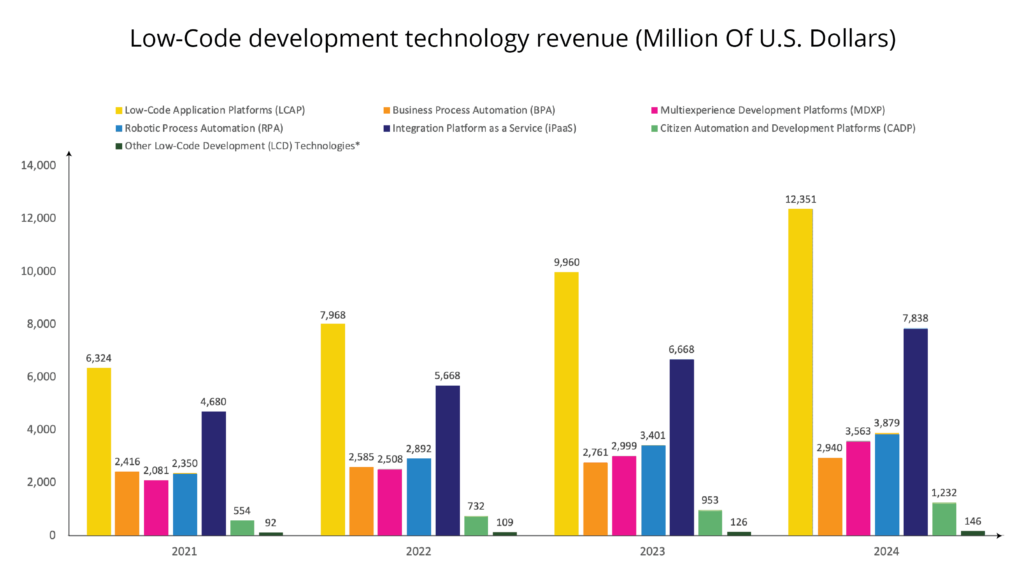
Understanding the low-code market landscape?
Just like any other technology, not all low-code platforms are created equal, and as such, not all are suitable for the same use cases.
If you’re currently evaluating low-code for a certain project, three criteria can help you understand the low-code market:
-
- Who is the targeted user of the platform?
- What functions and features does the platform include?
- What use cases does the platform address?
With that in mind, the low-code market can be grouped into three main categories:
-
- Regular low-code
- Enterprise level low-code
- High-performance low-code
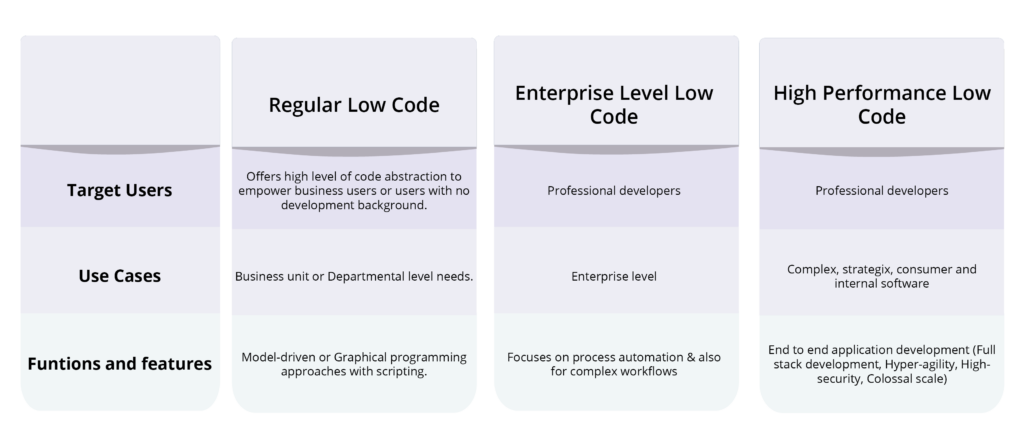
What’s the right low code no code platform for you?
This categorization doesn’t mean that one type of low-code platform is better than another; it always depends on your needs.
If you just want to empower your line of business to build simple apps, a regular Low-Code category is enough. But if you’re looking for a technology that supports your digital transformation initiatives, you should look for high-performance low-code.
The future of low code no code development
The low-code development market is expected to continue to grow in the years to come. This is due to the increasing demand for digital transformation, the need for rapid application development, and the desire for greater business agility. As the market grows, we can expect to see new low-code platforms emerge that address the challenges of low-code development, such as the lack of skilled resources and the complexity of some platforms. We can also expect to see more businesses adopt low-code development as they realize the benefits it can offer.
In conclusion, the low code no code trend is rapidly gaining momentum, driven by the increasing demand for digital solutions and the cost savings offered by low code no code solutions. With the predictions that no-code will be a crucial part of the business operations in the next five years, and at least 65% of all application development activity by 2025. It’s worth considering how your business can leverage no-code technology to stay ahead of the curve.
We at Amoga are building a low code no code platform that empowers businesses to build enterprise-grade applications 10x faster and at 25% lower cost than traditional software. Organizations can break free from complex software limitations with features such as Pre-built App templates, App Studio, visual UI builders, Form Builders, and Customized Workflow. Book your demo today and start building apps with Amoga.
Content Source – LinkedIn

